
- Jayden Higgins is a well-rounded receiver: He averaged at least 2.7 yards per route run over the last two seasons, regardless of whether he lined up out wide or in the slot, or faced man or zone defense.
- Higgins is an X receiver joining a great X receiver: The Houston Texans already have Nico Collins as their X receiver, so they will need to get creative to deploy Higgins and Collins at the same time.
- Final chance to claim 25% off PFF+: Use code DRAFT25 and unlock access to player grades, fantasy tools and the 2025 Draft Guide.
Estimated Reading Time: 5 minutes

PFF’s Fantasy Football Player Profile series delivers the most in-depth fantasy football analysis available for the 2025 season.
Using PFF’s exclusive data, we evaluate player performance, competition for touches and how teammates and coaching staffs will impact each player’s fantasy football outlook.
Last updated: 7:15 a.m. Friday, May 2
Click here for more draft tools:
NFL Draft Big Board | Mock Draft Simulator | NCAA Premium Stats
2025 PFF Draft Guide | Mock Draft Hub | Prospect Data Profiles
Draft Position Rankings
Player performance
Jayden Higgins spent his first two collegiate seasons at Eastern Kentucky before transferring to Iowa State and becoming their lead receiver. In 2023, Higgins led the wide receiver room in routes run, but there was more of a rotation of receivers, with five players who received at least 150 offensive snaps. In 2024, Higgins again led the team in routes, but he and Jaylin Noel were much higher than the other players on the depth chart, as only one other receiver played at least 150 offensive snaps.
Higgins made his mark on very efficient play, constantly making catches down the field, leading to first downs and a high yards per route run mark. His efficiency numbers weren’t all that different in 2023 compared to 2024, but his target rate increased as well as his routes run, leading to more cumulative stats. While he primarily played outside and typically faced zone defense, he was able to find success regardless of where he lined up and what defense he faced. He was generally effective at most routes, but there were a few in breaking routes where he was less effective.
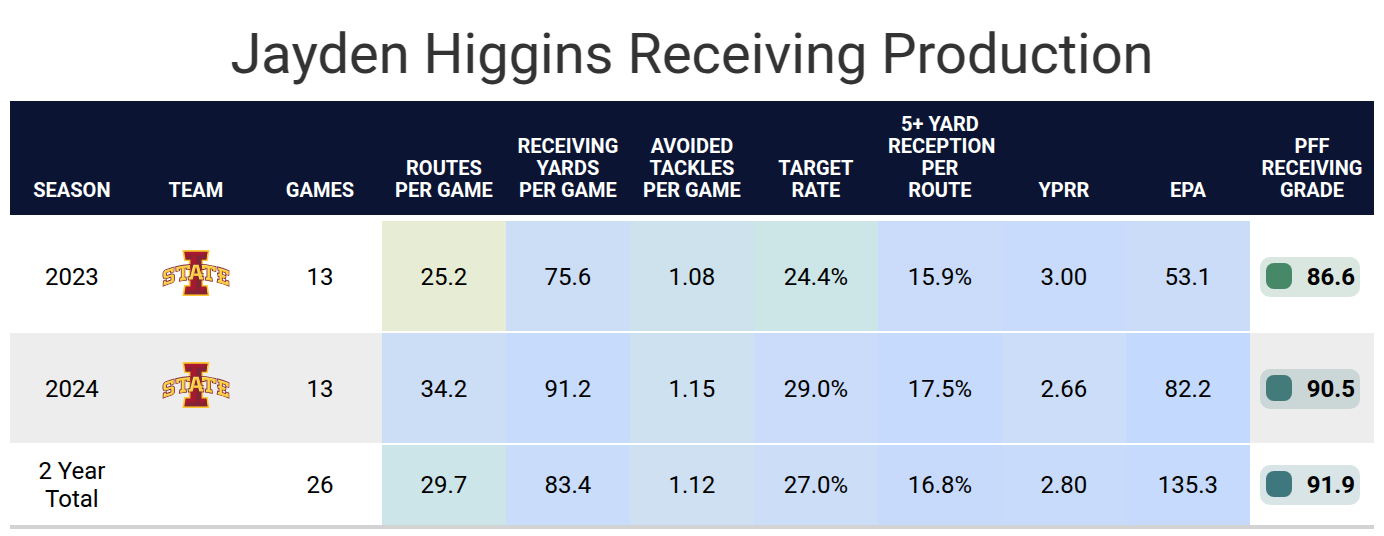
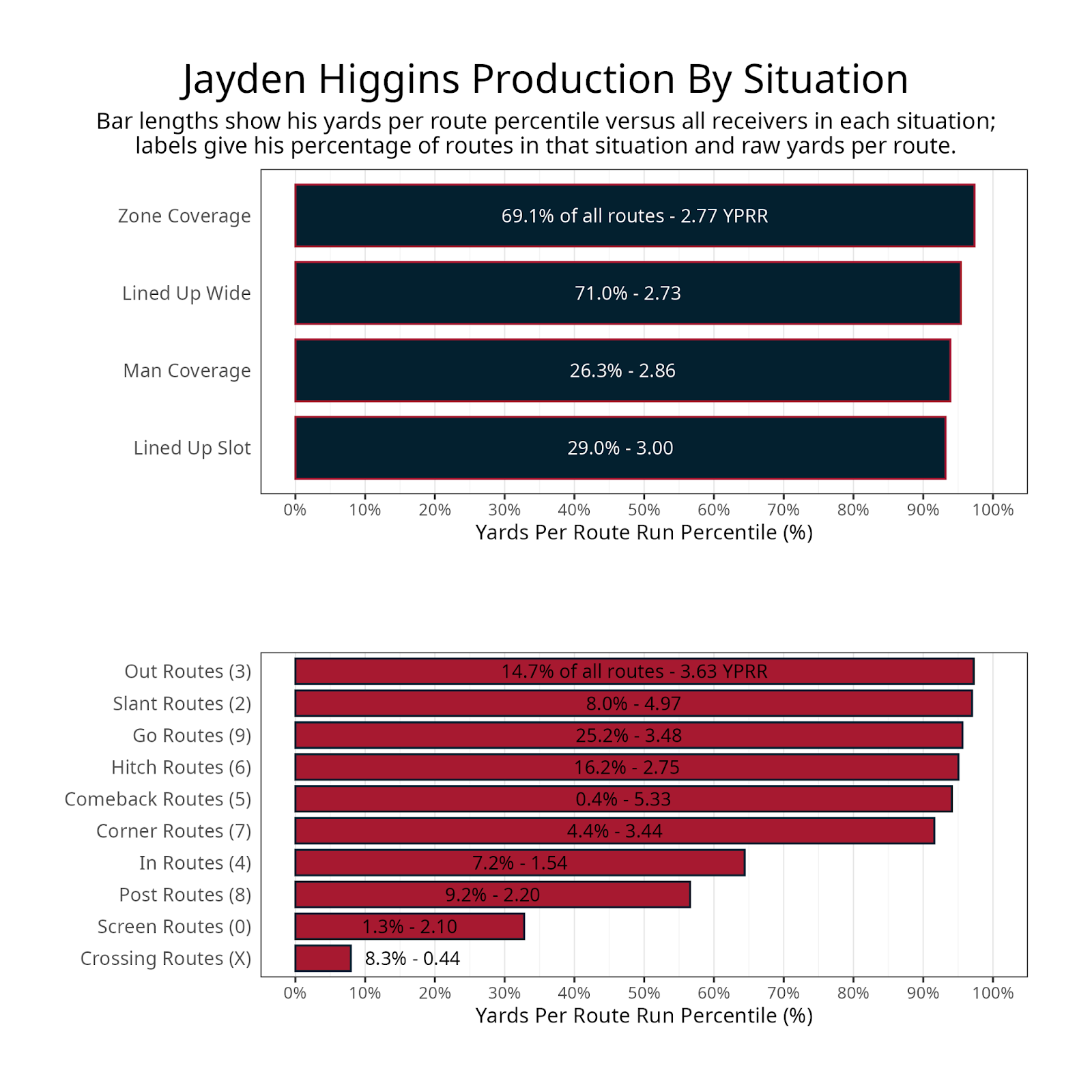
Projected role
Higgins is a prototypical X receiver at 6-foot-4 and 217 pounds. While our draft guide compared him to Tim Patrick, some others compared him to his new teammate, Nico Collins.
The Texans had a clear need for more receivers, and they’ve found a lot of potential replacements. Tank Dell is likely to miss most if not all of the 2025 season. Stefon Diggs played significantly and at a high level last season before his injury, and his absence was missed. Houston added Christian Kirk via trade, Justin Watson and Braxton Berrios in free agency, and then Higgins and his fellow Iowa State teammate Jaylin Noel in the draft.
Collins, Kirk, Higgins and Noel are locked into roster spots, while Watson and Berrios will compete with John Metchie III and Xavier Hutchinson for the last two spots, or the last spot once Dell is available.
Chances are, the Texans will go with Collins and Higgins as the outside receivers, and Kirk or potentially Noel in the slot. However, both Kirk and Noel have experience as a Z receiver. The Collins and Higgins pairing is unusual in the NFL. There have only been five times in the last decade when a team had two 6-foot-4 or taller wide receivers, and each player reached 500 receiving yards. In no case were both wide receivers worth starting in fantasy. Higgins may function mainly as a backup for Collins, a wide receiver who has missed at least two games every season. Then one of Kirk and Noel plays in the slot and the other at Z.
The most likely scenario is that there is no clear distinction between starter and backup. All four wide receivers could play significant snaps, which could make it harder for Kirk, Higgins or Noel to have fantasy value. If Collins were to suffer an injury, Higgins would naturally fill Collins’ role and potentially take his high target rate. This would likely lead to Higgins being a clear fantasy starter if his talent can transfer over to the NFL as a rookie

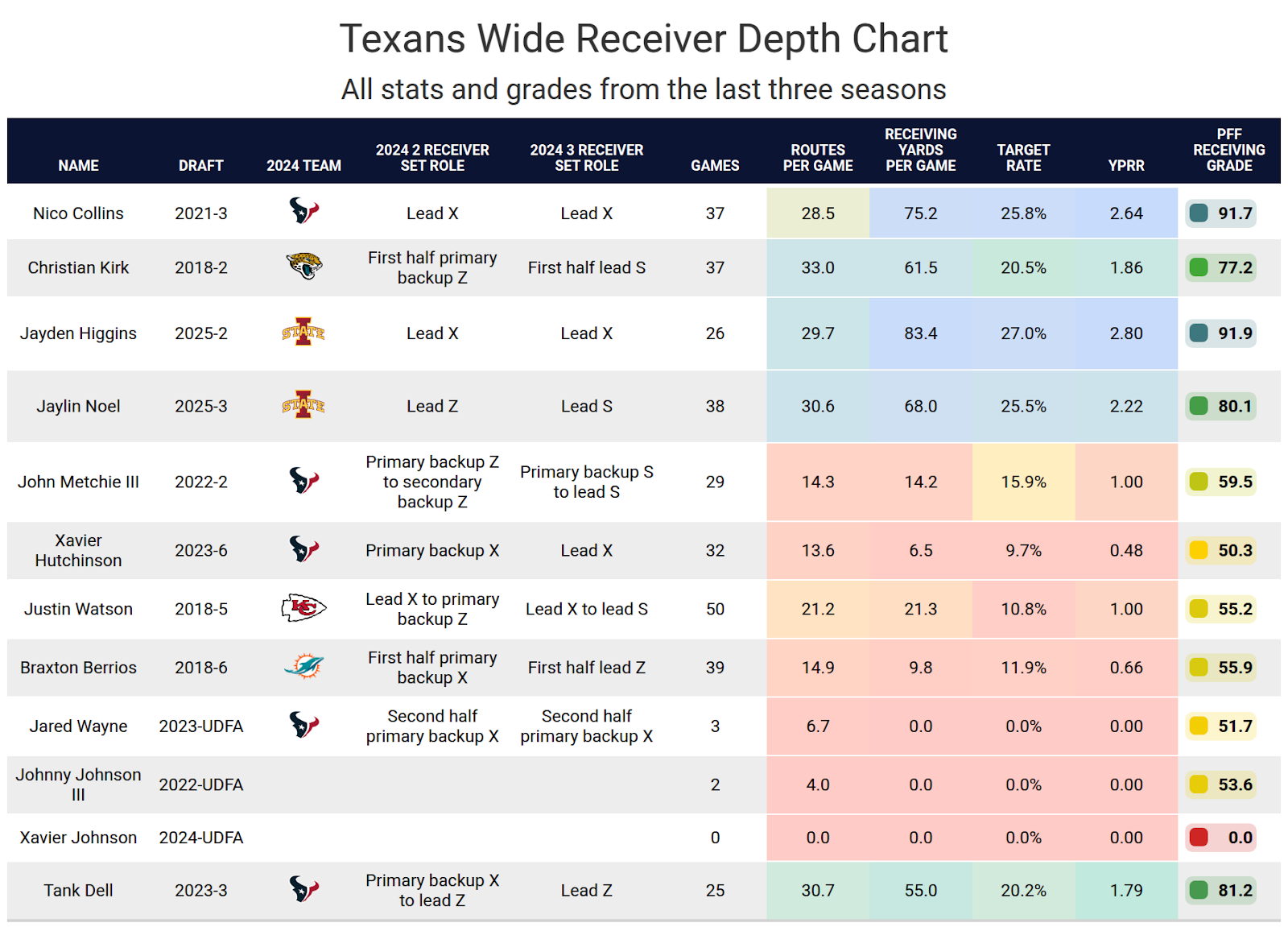
Impact of teammates
The Texans’ new offensive coordinator is Nick Caley, who has never previously been in charge of an offense. On the bright side, he most recently was a coach on the Los Angeles Rams, where 11 personnel is the base offense and wide receivers are the clear focal point of the passing game. On the downside, Caley is a long-time tight end coach, and there is a chance he might prioritize tight ends more than the usual coach.
Higgins lands with C.J. Stroud, which should be viewed as more of a positive than a negative. While Stroud didn’t receive as high a grade in 2024 as he did in 2023, he generally played well to close out the season. His 82.8 offensive grade from Week 13 on, including the playoffs, was ninth-best among quarterbacks. Stroud’s also had a high rate of targeting wide receivers. He’s been relatively neutral in terms of how often he throws deep, and Higgins has had a relatively neutral deep target rate in college.
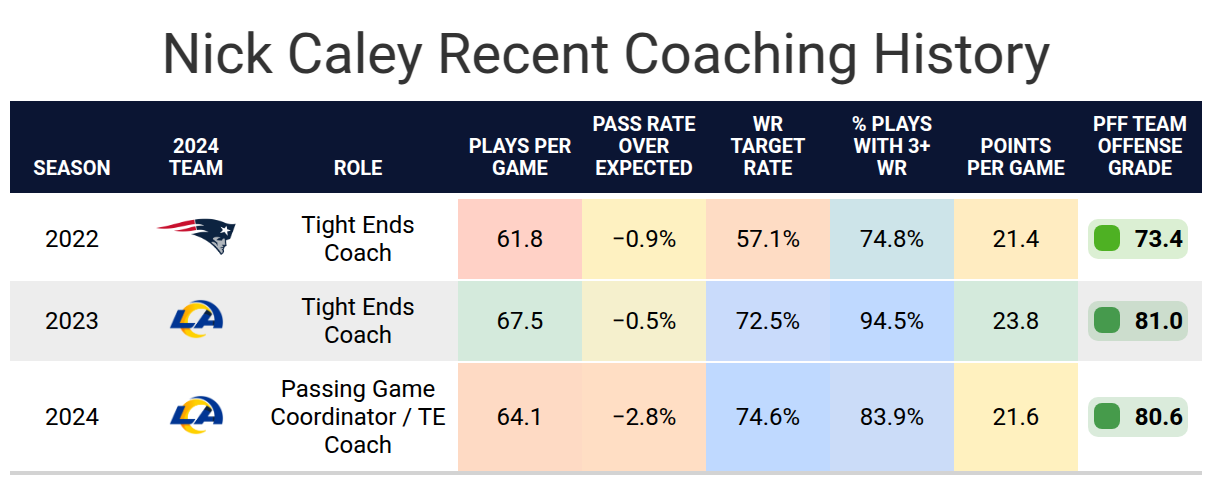
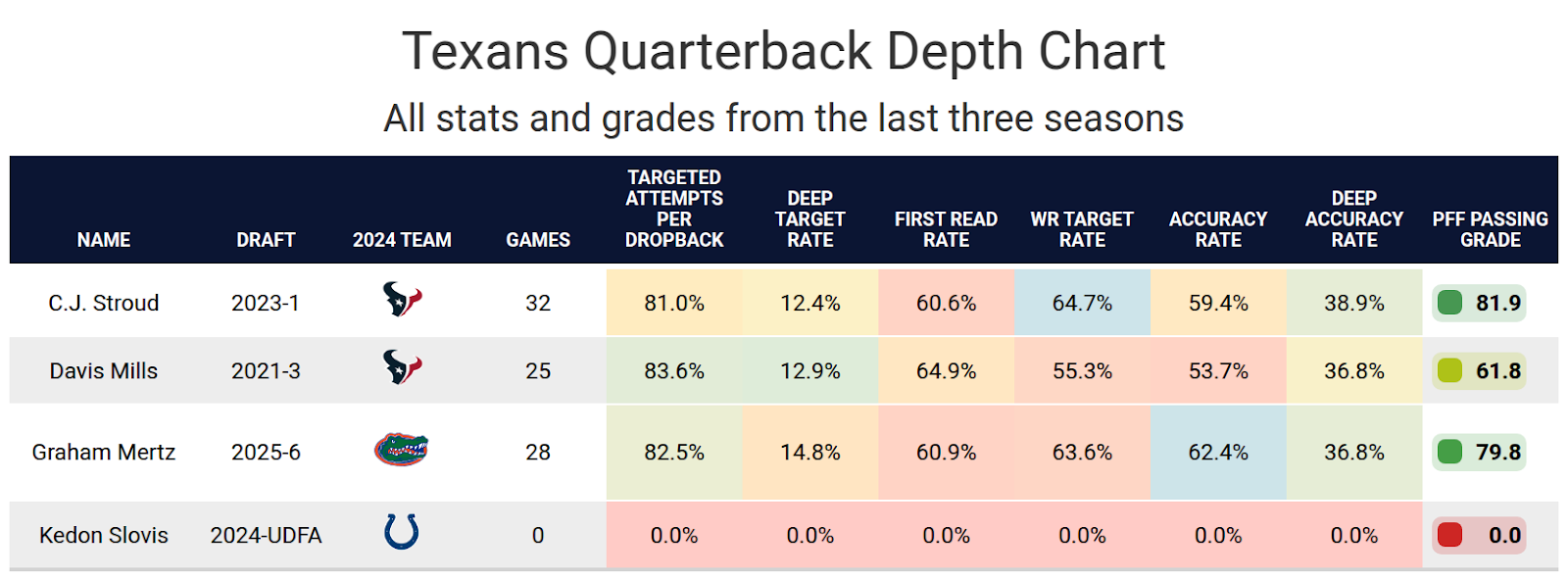
Bottom line
Higgins was the 34th overall pick, and any wide receiver selected that high is worth the risk in fantasy. However, his landing spot with the Houston Texans is a bit awkward, as Higgins shares an overlapping skillset with Nico Collins, and the team has eight total receivers averaging at least 10 routes per game.
Footnotes
- Statistics in tables and charts were chosen based on their ability to predict future fantasy performance on a per-game or per-opportunity basis or to describe the player relative to others at the same position.
- “Opportunities” are defined as passing dropbacks, rushing attempts and routes run as a receiver.
- Numbers are provided either by season or based on the past three years. For rookies, only college statistics are included. For non-rookies, only NFL statistics are considered, regardless of whether they played in college within the previous three years.
- As college competition is easier than NFL competition, most rookies are likely to see a decline from their historical numbers.
- Only FBS data is considered for college players and comparisons.
- Kneel-downs are removed from rushing data to provide cleaner quarterback rushing rate statistics.
- The table colors in this article range from blue (indicating good/high) to red (indicating bad/low).
- All percentiles and color codings compare the given player to others with a high sample of opportunities. Generally, the cutoff is one-third of the possible opportunities in the sample. If a player does not meet the threshold, they are still included in the comparison, though their results may appear better or worse than expected due to the smaller, less predictive sample size.
- Information on utilization classifications and their importance can be found here for running backs, wide receivers and tight ends.
This news was originally published on this post .










Be the first to leave a comment